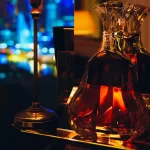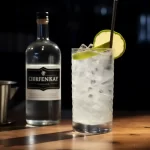Gin is a clear, distilled spirit that derives its predominant flavour from juniper berries. It is often combined with a variety of botanicals, including coriander, angelica root, and citrus peel. Gin can be enjoyed neat, on the rocks, or as a component in a variety of cocktails.
The History of Gin
The history of gin can be traced back to the 17th century in the Netherlands, where it was originally created for medicinal purposes. It quickly spread throughout Europe, with England becoming the epicenter of gin production in the 18th century. Gin became popular due to its affordability and easy accessibility, leading to an epidemic of drunkenness and social problems known as the “gin craze.” However, gin has since evolved to become a respected and beloved spirit in the world of mixology.
How Gin is Made
Gin is made by distilling a neutral spirit with botanicals. The botanicals are typically added to the neutral spirit in a pot still or a column still, and the resulting distillate is then blended with water to reduce the alcohol content. The amount and type of botanicals used vary depending on the type of gin being produced.
Types of Gin
There are four main types of gin: London Dry Gin, Old Tom Gin, Plymouth Gin, and Genever Gin.
London Dry Gin
London Dry Gin is the most popular type of gin, known for its dry, piney taste. It must be made using only natural botanicals and cannot contain any added sweeteners.
Old Tom Gin
Old Tom Gin is a sweetened gin that was popular in the 18th and 19th centuries. It has a more complex flavour profile than London Dry Gin, with a hint of sweetness.
Plymouth Gin
Plymouth Gin is a type of gin that can only be produced in Plymouth, England. It has a slightly sweeter taste than London Dry Gin and is known for its smoothness.
Genever Gin
Genever Gin, also known as Dutch Gin, is a traditional style of gin that is distilled from malt wine. It has a more malty and full-bodied flavour than other types of gin.
Popular Gin-Based Cocktails
Gin is a versatile spirit that can be used in a variety of cocktails. Here are some of the most popular gin-based cocktails:
Gin and Tonic
A classic gin and tonic is made with gin, tonic water, and a slice of lime. It is a refreshing and simple cocktail that is perfect for any occasion.
The martini is a timeless cocktail that is made with gin and vermouth. It can be garnished with a twist of lemon or a green olive.
Negroni
The Negroni is a popular cocktail that is made with gin, sweet vermouth, and Campari. It has a bitter and complex taste that is often garnished with an orange peel.
Tom Collins
The Tom Collins is a refreshing cocktail that is made with gin, lemon juice, simple syrup, and soda water. It is typically served in a tall glass with ice and a slice of lemon.
Aviation
The Aviation is a classic cocktail that is made with gin, maraschino liqueur, lemon juice, and crème de violette. It has a floral and slightly sweet taste that is often garnished with a cherry.
How to Serve Gin
Gin can be served in a variety of ways, depending on personal preference. It can be enjoyed neat, on the rocks, or as a component in a cocktail. When serving gin neat or on the rocks, it is recommended to use a chilled glass to enhance the flavour and aroma of the spirit.
Pairing Gin with Food
Gin can be paired with a variety of foods, including seafood, spicy dishes, and light salads. The botanicals in gin complement the flavours of many dishes, making it a versatile spirit for food pairing.
Gin in Pop Culture
Gin has had a significant impact on popular culture, appearing in literature, music, and film. From James Bond’s famous martini to F. Scott Fitzgerald’s gin-based cocktails, gin has been a beloved spirit in popular culture for decades.
Gin Distilleries to Visit
There are many gin distilleries around the world that offer tours and tastings. Some of the most popular gin distilleries to visit include the Bombay Sapphire Distillery in Hampshire, England, and the Sipsmith Distillery in London, England.
The Future of Gin
As the popularity of gin continues to grow, there is a renewed focus on sustainability and local production. Many distilleries are using locally sourced botanicals and implementing eco-friendly practices to reduce their environmental impact.
Conclusion
Gin has a rich history and has become a beloved spirit in the world of mixology. From classic gin and tonics to creative cocktails, gin offers a wide range of flavours and pairings. With a focus on sustainability and local production, the future of gin looks bright.
FAQs
Is gin gluten-free?
Yes, gin is typically gluten-free as it is made from a neutral grain spirit.
Can gin be aged like whiskey?
Gin can be aged in barrels, but it is not common. Barrel-aged gin has a slightly different taste and colour than regular gin.
What is the difference between gin and vodka?
The main difference between gin and vodka is that gin is infused with botanicals, while vodka is typically unflavoured.
Can gin be made at home?
Yes, gin can be made at home using a variety of botanicals and a neutral grain spirit.
How should gin be stored?
Gin should be stored in a cool, dark place away from direct sunlight to maintain its flavour and quality.









